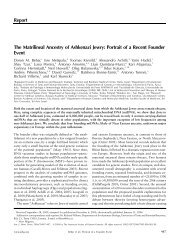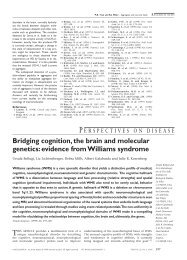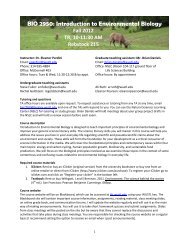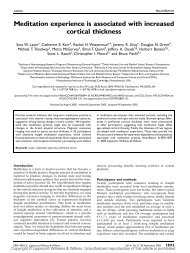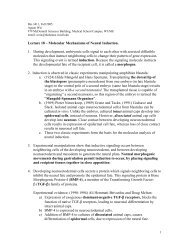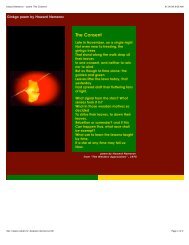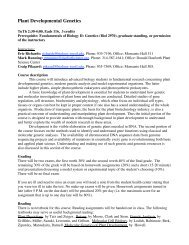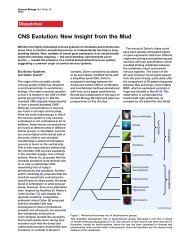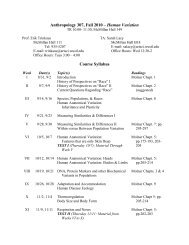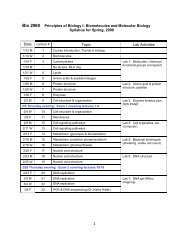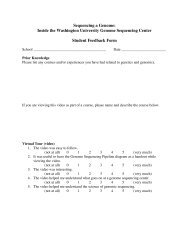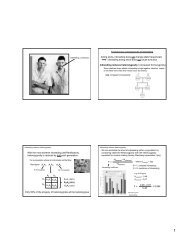Expression Cloning of noggin, a New Dorsalizing Factor Localized ...
Expression Cloning of noggin, a New Dorsalizing Factor Localized ...
Expression Cloning of noggin, a New Dorsalizing Factor Localized ...
Create successful ePaper yourself
Turn your PDF publications into a flip-book with our unique Google optimized e-Paper software.
from dorsalized gastrulae (treated with LiCl during blastula<br />
stages) was size fractionated and the active fraction used<br />
to construct a plasmid cDNA library. RNAs were synthesized<br />
from pools <strong>of</strong> plasmids and injected into ventralized<br />
embryos produced by UV treatment (Smith and Harland,<br />
1991). Pools <strong>of</strong> plasmid DNA that directed the synthesis<br />
<strong>of</strong> dorsalizing RNA were sib selected until single active<br />
clones were isolated. In the first screen we isolated Xwnf-8,<br />
which was surprising since Xwnt-8 is down-regulated by<br />
LiCl treatment. We therefore reexamined the initial pools<br />
<strong>of</strong> 10,000 clones to ask whether Xwnt-8 was the only dorsalizing<br />
activity present.<br />
The 10 pools <strong>of</strong> 10,000 clones were analyzed by filter<br />
hybridization for the presence <strong>of</strong> Xwnt-8. The result is<br />
shown in Figure 1A. Xwnt-8 clones were present in the<br />
two active pools (8 and 9), as well as in five others. The<br />
retrospective analysis demonstrates that although Xwnr-8<br />
is less abundant in RNA from dorsalized gastrulae, it is<br />
still an abundant mRNA that is highly represented in the<br />
library.<br />
In the isolation <strong>of</strong> Xwnt-8 (Smith and Harland, 1991)<br />
pool 9 was selected for subsequent sib selections. The<br />
Xwnt-8 hybridization signal was weaker in pool 8 than in<br />
pool 9 and not much different from the inactive pools that<br />
contained Xwnf-8. To test whether pool 8 contained dorsalizing<br />
activities other than Xwnt-8, it was subdivided into<br />
12 pools <strong>of</strong> 1000 clones. Five <strong>of</strong> the pools had activity in<br />
the rescue assay and three <strong>of</strong> these did not contain Xwnt-8.<br />
The Xwnt-b-negative pool with the strongest dorsal axisrescuing<br />
activity, pool 8.12, was further sib selected until<br />
a single active clone was isolated (clone A3 from pool<br />
8.12.12.A). The activity <strong>of</strong> the pools (i.e., the degree <strong>of</strong><br />
dorsal axis rescued) increased as progressively smaller<br />
pools <strong>of</strong> clones were assayed. At the second sib selection<br />
<strong>of</strong> the library (pools <strong>of</strong> 1000 clones), A3 hybridizing clones<br />
could account for the activity <strong>of</strong> all dorsalizing pools that<br />
A. Pool: 1 2 3 4 5 6 7 8 9 10<br />
Activity: - - - - - - - + _ + _ -<br />
Xwnt-6-b<br />
Figure 1. Detection <strong>of</strong> Xwnf-8 and <strong>noggin</strong> Clones in Sib Selection<br />
Pools<br />
Five microgram samples <strong>of</strong> library plasmid DNA from the first (A) and<br />
second (6) sib selections (10,000 and 1,006 clones per pool, respectively)<br />
were digested with EcoRl and EcoRV, separated on 1% agarose<br />
gels, and transferred to nylon membranes. The membranes were hybridized<br />
with an Xwnt-8 probe alone (A) or first with Xwnt-8 and then<br />
with <strong>noggin</strong> probes (6). The activities <strong>of</strong> the various pools in the dorsal<br />
axis rescue assay are indicated (plus or minus).<br />
did not contain Xwnt-8 (Figure 16). One pool <strong>of</strong> 1000<br />
clones (8.2) hybridized with the A3 probe but did not have<br />
activity in the assay (Figure 16). The reason for this is<br />
unknown, although it is possible that this particular A3<br />
hybridizing clone was not functional. In addition, at this<br />
stage in the sib selection the active pools only conferred<br />
partial rescue <strong>of</strong> dorsal development, and pools with dorsalizing<br />
RNAs could have been missed.<br />
Finally, preliminary results indicate that at least one additional<br />
dorsalizing activity may be present in our library.<br />
RNA transcribed from Ncol linearized library plasmid DNA<br />
(rather than Notl linearized) retained axis-rescuing activity.<br />
Ncol cleaves within the 5’ untranslated region <strong>of</strong> A3 and<br />
within the coding region <strong>of</strong> Xwnt-8 and yields truncated,<br />
nonfunctional transcripts. The completeness <strong>of</strong> Ncol<br />
cleavage <strong>of</strong> A3 and Xwnt-8 plasmids in the pool was confirmed<br />
by blotting (data not shown).<br />
<strong>noggin</strong> cDNA Encodes a Novel Polypeptide<br />
The 1834 nt sequence <strong>of</strong> the A3 clone is shown in Figure<br />
2A. The sequence contains a single long open reading<br />
frame encoding a 222 aa polypeptide with a predicted molecular<br />
size <strong>of</strong> 26 kd. At the amino terminus, a hydrophobic<br />
stretch <strong>of</strong> amino acids suggests that the polypeptide enters<br />
the secretory pathway (Figure 26). There is a single<br />
potential site for N-linked glycosylation (see the asterisk in<br />
Figure 2A). Extensive untranslated regions are located<br />
both 5’and 3’<strong>of</strong> the reading frame (594 and 573 bp, respectively).<br />
The 3’ untranslated region is particularly rich in<br />
repeated dA and dT nucleotides, and contains, in addition<br />
to a polyadenylation signal sequence located 24 bp upstream<br />
<strong>of</strong> the start <strong>of</strong> the poly(A) tail, a second potential<br />
polyadenylation sequence 147 bp further upstream (both<br />
are underlined in Figure 2A).<br />
In vitro translation <strong>of</strong> RNA synthesized from the A3 clone<br />
resulted in a protein product with the approximate molecular<br />
weight predicted by the open reading frame (data not<br />
shown). Comparison <strong>of</strong> the amino acid sequence <strong>of</strong> the<br />
predicted polypeptide to the National Center for Biotechnology<br />
Information BLAST network (nonredundant data<br />
base) did not identify any similar sequence. Clone A3 thus<br />
appears to encode a new type <strong>of</strong> protein that may be secreted<br />
and that has dorsal-inducing activity in Xenopus.<br />
<strong>noggin</strong> mRNA Can Rescue a Complete<br />
Dorsal-Ventral Axis<br />
The new sequence, and its putative protein product, were<br />
named <strong>noggin</strong> based upon the phenotype resulting from<br />
mRNA injection into ventralized embryos (see below). Injection<br />
<strong>of</strong> <strong>noggin</strong> RNA into a single blastomere <strong>of</strong> a 4-cell<br />
stage UV-ventralized embryo can restore the complete<br />
spectrum <strong>of</strong> dorsal structures. The degree <strong>of</strong> axis rescue<br />
was dependent upon the amount <strong>of</strong> RNA injected: the embryos<br />
that received low doses had only posterior dorsal<br />
structures, while embryos that received higher doses had<br />
excess dorsal-anterior tissue. RNA transcripts from two<br />
<strong>noggin</strong> plasmids were tested. The first (A3) contained the<br />
full cDNA. The second @NogginAY) had a deletion removing<br />
the first 513 nt <strong>of</strong> the 5’ untranslated region up to the<br />
EcoRl site (see Figure 2A). The results <strong>of</strong> injection <strong>of</strong> RNA



